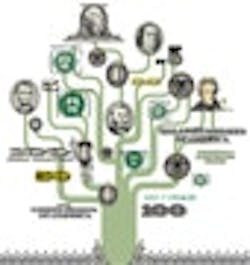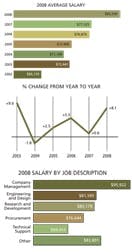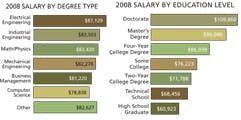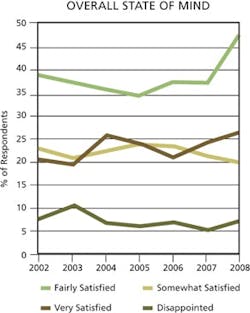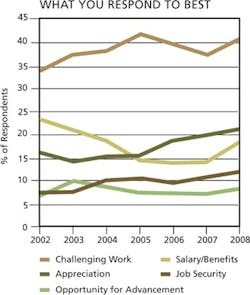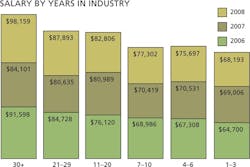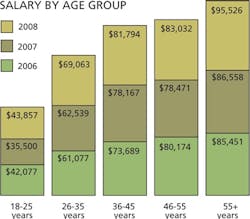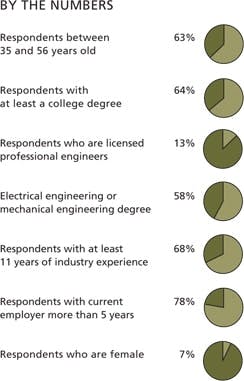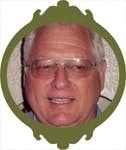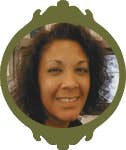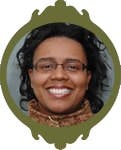What Cost, These Controls Engineers?
By Mike Bacidore, Managing Editor
The average pay for a controls engineer made its second-largest jump in the history of our annual salary and state-of-mind survey. Highlighted by an increase of more than 8%, the yearly assessment of what OEMs are spending on the brains behind the brains inside the machines revealed few new surprises. The cost of controls engineers, just like the cost of gasoline or anything else in limited supply and high demand, is going up.
“Employers, as well as practicing engineers, need to do more to help local school systems and organizations like the National Society of Black Engineers and the Society of Women Engineers to foster an appreciation of the STEM curriculum,” says Sybil Barco, design engineer I at Fluor Power Group in Charlotte, N.C. “Without this grassroots effort, the shortage of capable technically prepared candidates will grow.”
And when you combine the attractiveness of salaries and job satisfaction with the push by organizations like NSBE, SWE and FIRST to direct traditionally underrepresented groups, like females or ethnic minorities, down this career path, controls engineering could see an influx of women to quell the claims of a short supply of talent.
Everybody Wins
The average salary of a controls engineer, according to our survey is $83,559, and almost to a category everyone in the profession saw financial increases over 2007. Remarkably, about two-thirds of participants said they received a bonus this past year, and the bonus exceeded 10% for almost 14% of those responding to the survey.
Individuals with an industrial engineering degree saw staggering rewards in pay, leaping from less than $72,000 in the previous year’s survey to more than $83,000 in 2008. Figures for those with an electrical engineering degree also increased significantly from less than $80,000 in 2007 to more than $87,000 this year. Math/physics majors’ salaries, however dropped sharply, from almost $99,000 to almost $83,000, which could account for the rise in the other degrees. Almost 60% of respondents reported having either an ME or an EE degree.
No shockers in the salaries reported based on educational level completed. The more education, the higher the earning power. Those with doctorate degrees remained significantly above $100,000, and engineers with master’s degrees fell just shy of six digits this year. And almost two-thirds of participants report having at least a four-year college degree.
The same goes for salaries based on age and years of service. The older you are and the longer you’ve been in the industry, the more money you’re making, according to respondents’ answers. And almost 70% of survey participants reported at least 11 years of industry experience.
Feeling Groovy
While financial compensation is the basic reward for controls engineers, individuals still placed more emphasis on the fulfilling nature of the work itself and the work environment. The general state of mind of controls engineers remained high. Almost three-quarters of respondents said they’re fairly satisfied or very satisfied with their job and their work. This groovy feeling could result directly from a steady supply of challenging work, which survey respondents once again ranked as their most impactful motivator. Appreciation for their work was the second most important motivational factor, while salary/benefits, job security and opportunity for advancement rounded out the bottom. Despite rising salaries and a low ranking of job security as a motivator, about 45% of participants voiced some concern about their job security, possibly a result of having seen the bottom drop out of the job market in previous years.
The Learning Curve
Education and training are an ongoing source for controls engineers to keep up-to-date with the latest technology and to revisit old principles and basics. Although years of education translate into a higher salary, more than half of our respondents said that mentoring programs were the most important and beneficial parts of their educational training when they began their careers as controls engineers. And almost 40% of survey participants claimed their current employers offer mentoring programs.
“It is helpful to have someone guide you through it, and just as importantly, help you understand how things work, what information is relevant and what is not, how to get things done and all the other small things that make the wheels turn,” says Choy-Hsien Lin, development engineer at StoraEnso in Hyltebruk, Sweden. Lin’s company doesn’t have an official mentoring program, but during a lengthy introductory program, new engineers make internal connections and have an opportunity to seek out an informal mentor, he says.
Approximately 61% of respondents said their companies offer reimbursed continuing education, and yet only 34% had taken advantage of it. Roughly half of the survey participants said they find some benefit in educational classes offered by suppliers.
Methodology
Earlier this year, we emailed invitations to our subscribers and included a link to the survey in several of our newsletters. Usable survey responses were returned to us from 1.074 participants. Results were analyzed and additional interviews were conducted. For specific information about the survey results, contact [email protected] or phone toll-free 800/984-7644, ext. 444.
Profile: Choy-Hsien Lin
Development Engineer
Stora Enso Newsprint and Book Paper
Hyltebruk, Sweden
Choy-Hsien Lin always knew his career would be in engineering or science. “There has almost never been any doubt for me,” he says. “Understanding my environment and learning have always been central for me. Despite all the history, from a scientific point of view, it is uncharted lands I'm entering, and every day I learn more about the processes and systematically bring order and control to the seeming chaos.”
Lin received his initial engineering training at the ABB Industrial High School in Sweden, where he had access to industrial class equipment and leading engineers as mentors and teachers. “I went on to Linkoping University and took a MSc in applied physics and electrical engineering with specializations in electronic materials and control, the latter under Lennart Ljung.” He also worked briefly at ABB with control system start-ups for turbines.
Now at Stora Enso, he redesigns small processes where a handful of variables need decoupling or other solutions not met by run-of-the-mill solutions technicians; he cooperates with external resources in major control designs, such as entire steam distributions or supervisory control of entire plants; and he acts in an advisory capacity to major projects, such as boiler rebuilds or major capacity increases. “Our company is an integrated pulp and paper mill with steam generation.”
Lin sees no problem with getting young engineers to the profession. “The control field has a good influx of new talent,” he says. “I mainly see a problem with the industry, not the profession. Most talents are drawn to the automotive, aerospace and other engineering development industries.”
Lin’s responsibilities include determining how current processes and controls and are intended to work. “This is where I often find that information from previous work is lacking,” he says. “The specifications for the implementations are often adequate, but the design choices are never available, making it necessary to redo much of the calculations. Since we often do not have specific expertise in the areas, they take even more time to complete and run a risk of forgetting certain aspects. Based on this I run projects to improve the process through better control made possible by modern controllers.”
Depending on the scope of the projects, he can run them in a small group or in cooperation with external consultants. “What we notice is that, even with the help of experts, we often overlook things in the original design, some because of special operating conditions and others because of technical limitations,” says Lin. “When we get to the point of selecting actual components, we also notice the long turnaround times for every adjustment, because it involves so many parties.”
Ed Lake
|
Greg Branch has worked for himself and for a variety of companies over the years, most recently with Janicki Industries, where he was developing a proprietary-design production system before the project was cut back, along with a companywide layoff. “During the past three decades I personally designed or led multi-disciplinary teams that created many award-wining products,” says Branch. “I led teams to develop new concepts into working products in industries which span agricultural processing, plastic processing and packaging. In many of these instances, I worked directly with customers to respond to their specific needs. Other products were a reflection of my own ideas for products which came to fruition under my direction.”
Although he is working for himself now, Branch is open to entertaining offers of employment from companies. “My 36 years of design and management experience are extensive,” he says. “I have run my own consulting business, supervised more than 30 technical people and led multi-discipline design teams.”
Branch’s own design experience includes material handling equipment, agricultural field equipment, food processing machinery, plastic processing and packaging machines. “I earned my master’s degree in mechanical engineering, developing a new plastic expansion process and the associated machinery,” says Branch, who co-founded MicroGreen Polymers, which manufactured a green disposable plastic food packaging based on the technology, with a fellow graduate student from University of Washington, Seattle.
Profile: Kyle Knoff
R&D Team Leader—Electronics and Controls
WestfaliaSurge
Galesville, Wis.
The dairy industry can be a dirty business. And Kyle Knoff sees that as one reason why young engineers aren’t flocking to it. “I do see less of a hands-on work ethic by the younger generation,” he explains. “With the dairy industry, that is of great concern, since our environment can be quite dirty at times. I don't think there is a shortage of young engineers, but I do see it perceived as less rewarding than IT or business degrees.”
For almost 10 years now, Knoff has been at WestfaliaSurge, where he’s been the lead electrical engineer, designing controls for everything from washing the pipelines to stand-alone controls for gates and operations of integrated systems for milking. “e have a large number of U.S., Canadian and now South American dealers and others I support,” says Knoff. “I oversee one electrical associate and one electrical PE. I design controls for milking cows and stalls, and I also integrate controls from our German office into the American product offering. We use RFID for identification of animals and a proprietary system on the PC for monitoring milk flow and maintaining data on all the cows at the dairy facility.”
Knoff started out in computer programming, but engineering seemed more exciting to him. “I like the combination of man/machine/animal interface, and working with dealers and the dairy industry is comfortable,” he explains. While earning his bachelor’s degree in applied science at University of Wisconsin-Parkside, Knoff worked as a drafter for Perigon Systems in Kenosha, Wis. “It is a small industrial controls firm,” he says. “Then I ran the drafting department for one year before graduation. I worked after graduation and was there six years total.”
Then he moved to Loves Park, Ill., where he worked for six years at Enkel, a company that makes paper splicers for feeding of printing presses. “I designed a control which automatically cut and taped, or prepped, the new roll for a 3000FPM flying paster,” says Knoff. “I also managed the programming and controls of the flying paster. All of these were PLC-operated, as we used a TI305.”
Profile: Rob Herrmann
Technical Project Leader
Sealed Air Shanklin
Ayer, Mass.
Rob Herrmann’s company designs and manufactures industrial packaging equipment. “While the equipment portion of our business is relatively small, it is important to the business as it complements the other areas,” he explains. “I am responsible for scheduling, organizing, prioritizing and just about all other aspects of certain projects.”
Herrmann became an engineer because he had a natural curiosity about how things worked, and he knew he wanted to be able to make things work better than what he’d had seen. “I enjoy being able to develop new ways to do things, solving technical problems and helping the company turn futuristic ideas into reality,” he says.
Herrmann earned his stripes as a mechanical engineer at Worcester Polytechnic Institute. “I spent some time in college working as a mechanical coop,” he explains. “When I left college I joined a small OEM, where I had to learn the controls and programming side of the equipment.” After he left there more than 10 years ago, he has been working as a controls engineer, leading up to a controls project engineer and to his current role as a technical project leader.
“I think young people are not encouraged enough to enter the engineering world,” he says. “Without teachers that show a passion for the sciences, the students are never exposed to it and do not develop an interest. During my education at WPI, I was involved in several activities that helped build my current skill set. These activities included a coop program, a study abroad program and my standard course work. One of the most influential activities was a specific senior-level course that focused on teaching students how to use their technical knowledge to solve a real problem. The course consisted of designing, building and testing a solution for a problem poised by a sponsoring company. The problem was a real issue for the company, and by the end of the seven-week class they expected a working solution.”
The sponsor supplied the background information, the technical solution guidance and the budget, explains Herrmann. “The professor supplied the guidance on how to approach the problem and how to work as a team,” he says. “The professor also placed other real-world types of constraints on the team to better simulate life outside of academia. The class was divided into teams: a design team, a manufacturing team, a testing team and a procurement team. Each team consisted of a manager and a supporting staff. I was the design team manager. During these seven weeks, I learned how difficult it is to manage a technical project and technical people and that a project’s success relies on both being managed properly.”
Herrmann says they also learned some real-life lessons in that class. “We were told, for example, that a key component to our solution was in stock and would arrive in two days,” he recalls. “After two weeks we found out the shipment was never made because the company supplying the part went on strike. This problem taught all of us that sometime things happen and that we must be able to adapt our plans to still be able to complete a project on time.”
Herrmann’s other most influential training came during his first professional job out of college. “I worked for a small OEM providing equipment for the paper industry,” he says. “Since my degree was in mechanical engineering, I was hired to support the mechanical design. There were only five engineers, including myself. The entire engineering staff was made up of mechanical engineers, with a single engineer responsible for the equipment controls, as well. I realized one engineer was overworked. I wanted to help, so I started working with him to learn the controls systems. I learned quickly that I enjoyed machine control as much, if not more, than mechanical design.”
As a result, Herrmann started focusing more on equipment controls. “When I left that company, I took a position that was supposed to evenly split my time between electrical design and mechanical design,” he says. “But when I left that company years later I still had not done any mechanical engineering. Currently I am focusing on projects that are generally controls-oriented. However, my experiences as both a mechanical and electrical engineer allow me to keep a much broader project perspective.”
Profile: Rosalind Allen
Control Systems Engineering
Bechtel
Houston
Sometimes, engineering is just in your blood. “My father was in mechanical engineering,” says Rosalind Allen. “I was good in math and science and not very good at memorizing, so biology was not a good move. I just picked chemical engineering. I took honors courses for math and science in high school, but I wasn’t in any science clubs or groups.”
Allen particularly enjoys the interaction with the other disciplines. “I love dealing with systems and dealing with the engineering group and learning more about other aspects,” she says. “I deal with the control sytems aspects on the units I’m responsible for, and I also do vendor print for some of the packages. Whenever a mechanical group buys a piece of equipment, we have to review the documents that the vendor submits. I deal with INtools and the index for adding and deleting all the points.”
Allen completed her bachelor’s degree at University of Houston. Her first job out of school was with a small valve sales company and Emerson representative called Puffer Sweizen. “I was interning and cooping at Puffer Sweizen,” she explains. “Once I began as a full-time employee, they sent me to the Delta V training for the product they represented. There were 12 engineers above me at Puffer Sweizen, and I worked with almost all of them on different projects. They were all very good at helping with the training.”
Allen doesn’t see a shortage of young engineers or job opportunities for them. “I don’t think there’s an engineer shortage,” she says. “We’re hiring young engineers left and right. There seems to be an abundance. But there’s a lot of competition for getting good people.”
Profile: Sybil Barco
Design Engineer I
Fluor Power Group
Charlotte, N.C.
Sybil Barco loved math and science all through her primary and secondary education. “When applying to college, engineering was the most logical fit,” she says. “I was unsure of the discipline until I actually arrived on campus.”
Barco received her degree from the University of Miami, and summer internships through Inroads helped her to find her path.
“I was involved with Inroads from my senior year in high school through my junior year in college,” she explains. “The organization focuses specifically on engineering and business majors. Students are placed with a sponsoring company in their major to see if it is truly a career they can follow and ultimately gain employment with the sponsoring company or similar company upon graduation. Each summer, business acumen and other skills are explored and taught.”
Barco currently works in the electrical controls group for an EPCC company that builds power plants. Distributed control systems and the associated hardware and software fill her daily thoughts. But she still gives back to the next generation of engineers by working with the local alumni extension chapter of the National Society of Black Engineers in establishing a mentoring/tutoring program with Charlotte-Mecklenburg Schools for the 2008-2009 school year.
“Employers, as well as practicing engineers, need to do more to help local school systems and organizations like NSBE and the Society of Women Engineers to foster an appreciation of the STEM curriculum,” says Barco. “Without this grassroots effort, the shortage of capable technically prepared candidates will grow.”
